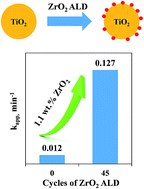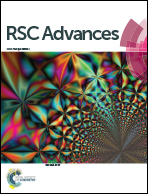Significant improvement in TiO2 photocatalytic activity through controllable ZrO2 deposition†
Abstract
ZrO2 was deposited on anatase TiO2 nanoparticles using 5–80 cycles of atomic layer deposition (ALD). The photocatalytic activity of all samples was evaluated based on the degradation of methylene blue (MB) solution under UV light. The TiO2 sample with 45 cycles of ZrO2 deposition (45c-Zr/TiO2, 1.1 wt% ZrO2) was proved to be the most efficient catalyst with a degradation kinetic constant 10 times larger than that of the pure TiO2 sample. All samples were characterized using inductively coupled plasma atomic emission spectroscopy (ICP-AES), nitrogen adsorption–desorption, X-ray diffraction (XRD), transmission electron microscopy (TEM), UV-vis diffuse reflectance spectra analysis (UV-DRS), Raman and photoluminescence (PL) techniques. The high photocatalytic activity of 45c-Zr/TiO2 can be attributed to stronger adsorption in the ultraviolet region and a reduction in the recombination rate of electron/hole pairs.



 Please wait while we load your content...
Please wait while we load your content...